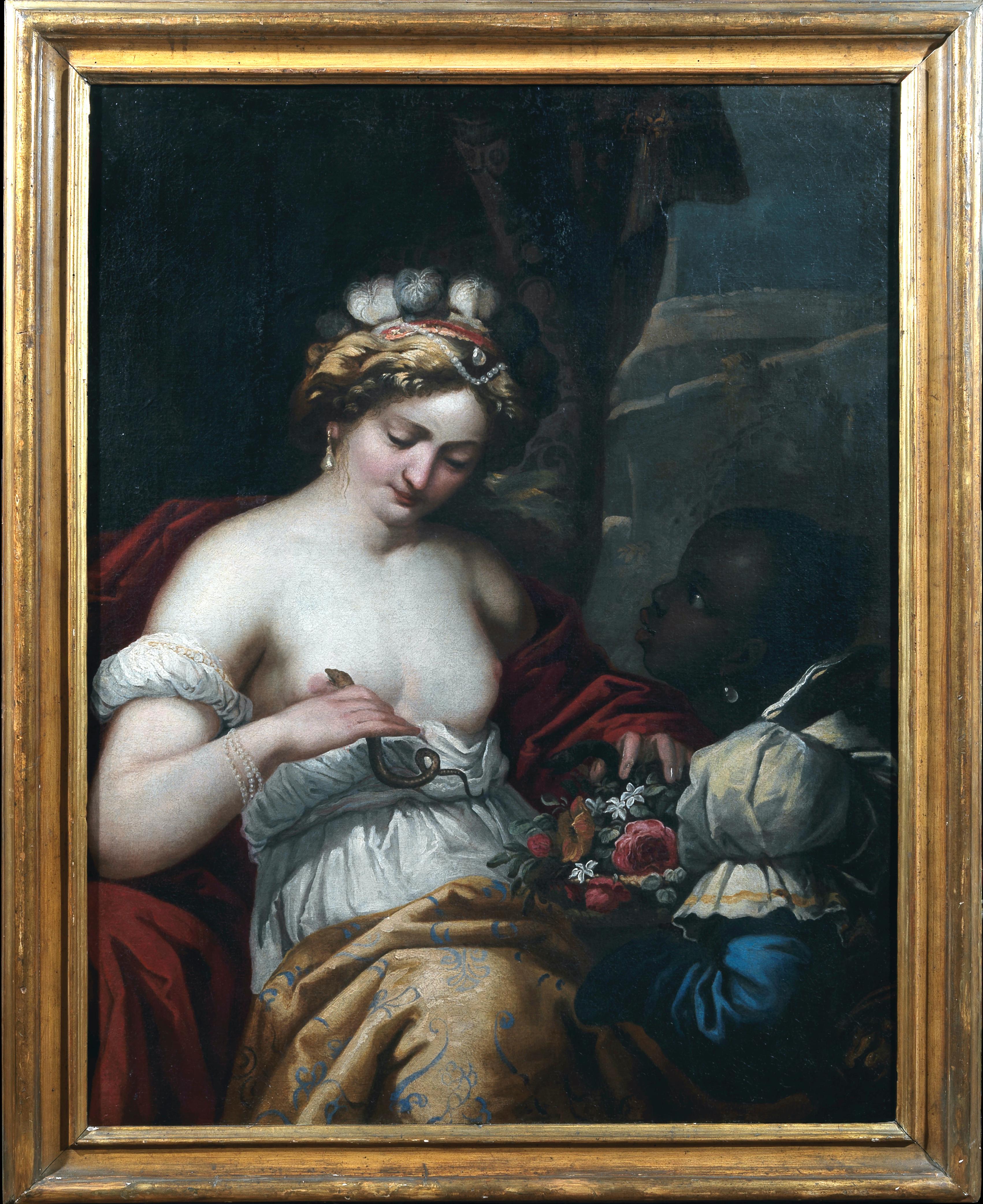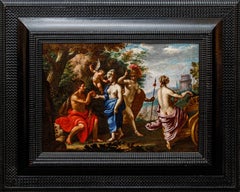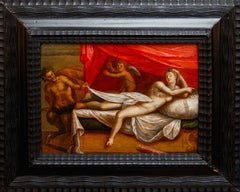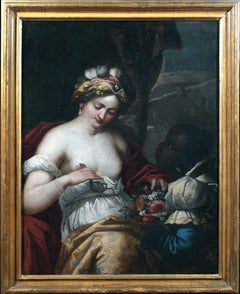Items Similar to By Jean Louis Victor Viger de Vigneau (Argentan, 1819- Paris, 1879), Cleopatra
Want more images or videos?
Request additional images or videos from the seller
1 of 9
Jean Louis Victor Viger de Vigneau (Argentan, 1819- Parigi, 1879)By Jean Louis Victor Viger de Vigneau (Argentan, 1819- Paris, 1879), Cleopatra19th Century
19th Century
$4,542.30
£3,440.90
€3,900
CA$6,292.74
A$7,057.73
CHF 3,696.02
MX$85,758.28
NOK 46,933.30
SEK 44,496.08
DKK 29,693.69
About the Item
Jean Louis Victor Viger de Vigneau (Argentan, 1819- Paris, 1879)
The Death of Cleopatra
Oil on panel, 21 x 28 cm
Framed, 34 x 39 cm
Signed at lower right "H. Viger. D."
Born in Argentan, Normandy, into a family of humble origins, at a very young age Viger de Vigneau, given his precocious and pronounced talent, was initiated into the painting profession, attending the graphic arts school founded in Rouen by Raymond Quinsac Monvoisin, a pupil of the famous Pierre Narcisse Guerin; the French painter's artistic training continued at the busy Parisian ateliers of painters Paul Delaroche, Martin Drolling and Henri Lehman. Thanks to his multifaceted upbringing, from his youth the artist developed an utterly personal style that aimed not at slavish emulation but at a shrewd reinterpretation of the models of the great masters of French academicism of the mid-19th century. The artist's works, beginning in the 1840s, are extremely well received in Parisian circles and are acquired by the aristocracy and the wealthiest members of the rising bourgeoisie of the time: absolutely positive are also the reviews regarding the works exhibited at the Salon, an event at which Jean Louis Victor Viger de Vigneau appears to be consistently present from 1845 onward. Great appreciation from his contemporaries was realized in 1850 when he was appointed secretary general of the Paris Committee of Artists. Beginning in 1859, the painter received numerous commissions, including cartoons for the three monumental stained glass windows in the choir of the Paris church of Saint-Leu, depicting Christ and the prophets Moses and Elijah. Beginning in the early 1860s, the artist worked directly for Napoleon III, producing several portraits and a series of canvases devoted to reconstructing the history of the imperial family. The artist had been hosted by Princess Eugenie, consort of the emperor, at Malmaison Castle, where he was commissioned to fresco the hall of honor. Upon his death in 1879, his friend the poet Emile Bertin dedicated a poem to him, published the following year in the miscellany Parnasse: "His work will remain, Viger! the great pages you have been able to retrace, and your fascinating panels, your vivid portraits will live on through the centuries, sustained, protected and consecrated by time." Expressing himself favorably with respect to Viger's work, in an 1879 article commemorating him, was the celebrated art critic Deschamps, who praised the Norman-born painter for his ability to depict the empire's most powerful figures in a magniloquent manner without, however, renouncing a lenticular realism.
In this painting, perfectly in line with the painting of the great French masters of the mid-19th century, foremost among them Courbet, the Egyptian queen is depicted nude, in an extremely sensual pose, reclining on a soft red damask triclinium. The agile and rapid brushstrokes as well as the rendering of the luster and transparency of the fabrics highlight the artist's extraordinary technical expertise, which can provide maximum emphasis on the intriguing female figure. Female subjects of mythological character recur frequently throughout Viger's pictorial corpus, as evidenced by Flora and Zephyr, a painting commissioned by Napoleon III whose location is unknown today (the work is currently known only through historical photographs).
- Creator:Jean Louis Victor Viger de Vigneau (Argentan, 1819- Parigi, 1879) (French)
- Creation Year:19th Century
- Dimensions:Height: 8.27 in (21 cm)Width: 11.03 in (28 cm)
- More Editions & Sizes:20x28Price: $4,542
- Medium:
- Period:
- Condition:
- Gallery Location:Milan, IT
- Reference Number:1stDibs: LU2639216355742
About the Seller
No Reviews Yet
Vetted Professional Seller
Every seller passes strict standards for authenticity and reliability
1stDibs seller since 2023
Typical response time: <1 hour
- ShippingRetrieving quote...Shipping from: Milan, Italy
- Return Policy
Authenticity Guarantee
In the unlikely event there’s an issue with an item’s authenticity, contact us within 1 year for a full refund. DetailsMoney-Back Guarantee
If your item is not as described, is damaged in transit, or does not arrive, contact us within 7 days for a full refund. Details24-Hour Cancellation
You have a 24-hour grace period in which to reconsider your purchase, with no questions asked.Vetted Professional Sellers
Our world-class sellers must adhere to strict standards for service and quality, maintaining the integrity of our listings.Price-Match Guarantee
If you find that a seller listed the same item for a lower price elsewhere, we’ll match it.Trusted Global Delivery
Our best-in-class carrier network provides specialized shipping options worldwide, including custom delivery.More From This Seller
View AllGiacomo Casa (Conegliano, 1827 - Rome, 1887), Allegory of Venice
Located in Milan, IT
Giacomo Casa (Conegliano, 1827 - Rome, 1887)
Allegory of Venice
Oil on canvas, 50.5 x 40 cm
With frame 65.5 x 53.5 cm
The Unification of Italy and its historical and political ...
Category
19th Century Other Art Style Figurative Paintings
Materials
Canvas, Oil
Girolamo Maria Pesci (Rome, 1679 - 1759), The judgment of Paris
Located in Milan, IT
Girolamo Maria Pesci (Rome, 1679 - 1759)
The judgment of Paris
c. 1705-1710
Oil on canvas, 47 x 36.5 cm
Girolamo Maria Pesci (Rome, 1679 - 1759), a figure distinguished for his e...
Category
18th Century and Earlier Other Art Style Figurative Paintings
Materials
Canvas, Oil
From Paolo Veronese, Allegory of Strength and Wisdom
By Paolo Veronese
Located in Milan, IT
Follower of Paolo Veronese (Verona, 1528 - Venice, 1588)
Allegory of wisdom and strength
Oil on canvas, 48 x 36.5 cm
Picture frame, 61 x 48 cm
The Allegory of Wisdom and Strength...
Category
16th Century Other Art Style Figurative Paintings
Materials
Canvas, Oil
Lambert Sustris's workshop (1515-1520 - c. 1584), Venus and Love Spied on
Located in Milan, IT
Lambert Sustris workshop (1515-1520 -approximately 1584)
Venus and Love spied on by a satyr
Oil on panel, 24 x 32 cm
Framed, 41 x 49 cm
The tablet described here, which can be at...
Category
18th Century and Earlier Other Art Style Figurative Paintings
Materials
Canvas, Oil
The Expulsion of Hagar painted by Ciro Ferri
Located in Milan, IT
Cyrus Ferri (Rome, 1634 - 1689)
The Expulsion of Hagar
Oil on canvas, 69 x 58.5 cm
Framed, 81 x 70 cm
The subject of the work belongs to the Old Testament stories: Hagar was the ...
Category
17th Century Figurative Paintings
Materials
Canvas, Oil
17th century, Bottega of Giovanni Francesco Romanelli, The Idolatry of Solomon
Located in Milan, IT
17th century, Roman School
Workshop of Giovanni Francesco Romanelli, known as the Viterbese (Viterbo, c. 1610 -1662)
Solomon's idolatry
Oil on canvas, 73.5 x 59.5 cm
The painting...
Category
17th Century Other Art Style Landscape Paintings
Materials
Canvas, Oil
You May Also Like
Cleopatra Queen of Egypt 17' century Painting Oil on Canvas
Located in Rome, IT
Amazing painting of Cleopatra oil on canvas with a gilt wood frame.
Attributed to Giuseppe Diamantini (Fossombrone 1621-Venice 1705)
The dramatic subje...
Category
Late 17th Century Academic Figurative Paintings
Materials
Oil
Cleopatra Queen of Egypt 17' century Painting Oil on Canvas
Located in Rome, IT
Amazing painting of Cleopatra oil on canvas with a gilt wood frame.
Attributed to Giuseppe Diamantini (Fossombrone 1621-Venice 1705)
The dramatic subje...
Category
Late 17th Century Academic Figurative Paintings
Materials
Oil
Cleopatra Queen of Egypt 17' century Painting Oil on Canvas
Located in Rome, IT
Amazing painting of Cleopatra oil on canvas with a gilt wood frame.
Attributed to Giuseppe Diamantini (Fossombrone 1621-Venice 1705)
The dramatic subje...
Category
Late 17th Century Academic Figurative Paintings
Materials
Oil
Cleopatra Queen of Egypt 17' century Painting Oil on Canvas
Located in Rome, IT
Amazing painting of Cleopatra oil on canvas with a gilt wood frame.
Attributed to Giuseppe Diamantini (Fossombrone 1621-Venice 1705)
The dramatic subje...
Category
Late 17th Century Academic Figurative Paintings
Materials
Oil
Cleopatra Queen of Egypt 17' century Painting Oil on Canvas
Located in Rome, IT
Amazing painting of Cleopatra oil on canvas with a gilt wood frame.
Attributed to Giuseppe Diamantini (Fossombrone 1621-Venice 1705)
The dramat...
Category
Late 17th Century Academic Figurative Paintings
Materials
Oil
Painting "Le Moineau de Lesbie" by C.G. Brun, French School, 1860
By Charles Guillaume Brun
Located in PARIS, FR
Dimensions with frame : Height : 116 cm (45.7 in.) ; Width : 144 cm (56.7 in.)
Dimensions without frame : Height : 85 cm (33.5 in.) ; Width : 118 cm (46.5 in.)
Atrium with a rich Pompeian decor in which a young woman lying on a bed is playing with a sparrow, not paying attention to the man sat at her feet.
This painting is a major work of art of C. G. Brun, well-know for the precision of his technic, by the elegance of its composition, the pureness of the colors, the refinement of the touch and the expressivity of the characters.
This rare intimist scene in a interior decorated in the Pompeian style perfectly illustrates the taste of the time for the discovery of the villas of Pompei, thanks to the archeological excavations of the 18th century and the books published about them. To arrange its interiors based on the models of the Pompeian villas is then a trend that the most important people of that time will follow, as the Prince Napoléon, cousin of the Emperor Napoléon III, who orders the construction of a splendid Pompeian villa on the Avenue Montaigne, of which nothing remains but a few pictures and a painting by Gustave Boulanger, dated 1861 and called Répétition du « Joueur de flûte » et de la « Femme de Diomède » chez le Prince Napoléon.
This painting illustrates the poem « Fletus passeris Lesbiae » from the collection « Carmina » written by Catulle (87-54 av. J.-C.) : in his work, the author, in love with Lesbie, a married woman living in Rome, puts on a show a sparrow as the main center of interest of its mistress who neglects her suitor.
This theme has been represented many times in painting, like the version by Raphaël Poggi exposed at the Salon of 1865, or Lawrence Alma-Tadema in 1866 or Edward Poynter in 1907.
Painting exposed, as reference number 467, at the Salon of 1861 on the picture rail of the Palais des Champs-Elysées
Charles Guillaume Brun, born in Montpellier in 1825 and died in Paris in 1908, was registered in 1847 at the Paris Beaux-Arts school, where he studied under the direction of François- Edouard Picot (1786-1868) and of Alexandre Cabanel (1823-1889). His participation in the Paris Salon began in 1851 with genre subjects (Young girl doing her morning prayer), but as soon as 1853, he regularly sent Orientalist scenes, located in Algeria (Prayer in 1859, Rendez-vous in Constantine in 1861, Moorish woman...
Category
Antique 1860s French Napoleon III Paintings
Materials
Giltwood, Canvas
More Ways To Browse
La Tavola
19th Century Corpus
Pierre Martin
Henri Deschamps
Atelier Courbet
Jean Victor Bertin
Louis Dell Olio
Al Coro
Maeght Lithograph
18th Century Architectural Engravings
Antique Bourbon
1960s Pop Art
Lithograph Prints Of Architecture
Rolling Stone Magazine
Picasso Color Lithograph
Vintage Western Art Prints
Transformation Sculpture
Unknown Mid Century Modern Painting










